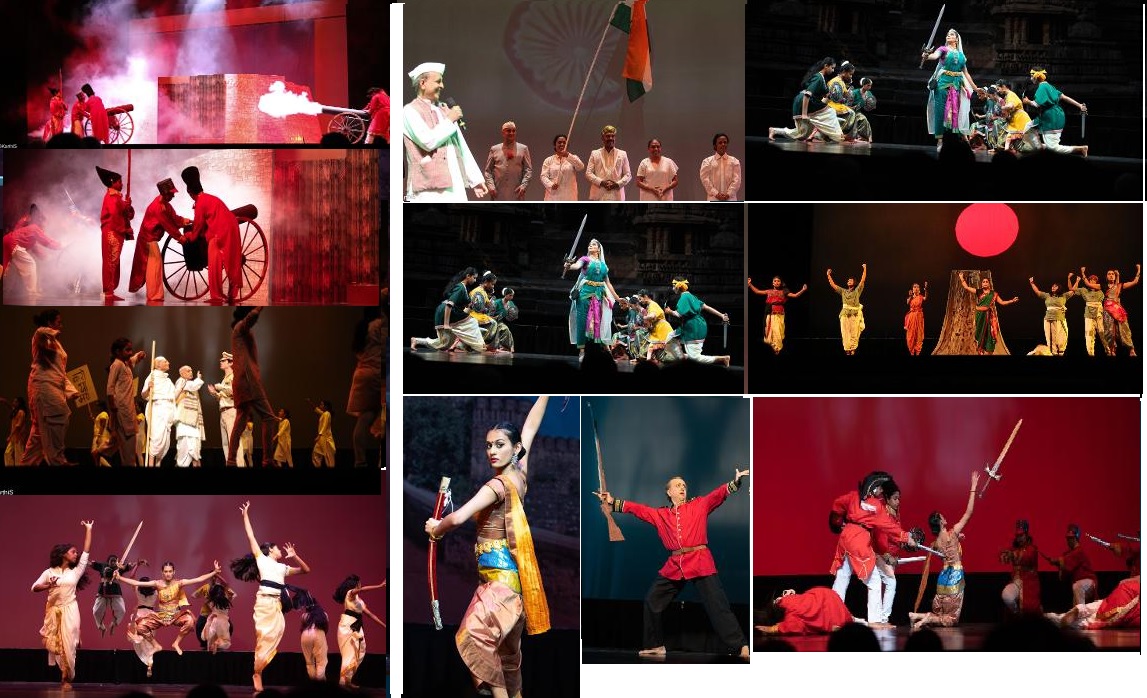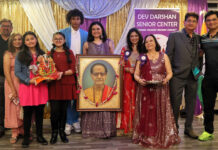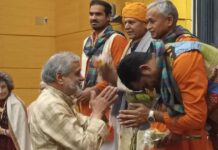Srilakshmi Vishnubhotla and Anitha Nagendra
ST LOUIS: “India’s 75th Independence day celebration happened all across the world by Indians. Many celebrated by hoisting the flags or having a small cultural show with Bollywood and patriotic songs. It was little different in Saint Louis, Missouri.
Indians from different States got together and represented their state’s contribution to India’s freedom through a magnificent dance-drama-music theatrical presentation. Historically speaking, few people’s names are always brought to forefront while debating on India’s Independence. But the work of Guruji Prasanna Kasthuri’s “Samarpan” – showcased those hidden stories of freedom struggle, many were not aware.
Soorya Performing Arts, a not-for-profit organization curated the show, involving 135 people. This show was witnessed by more than 1000 people in person and on online streaming. Audience was not bothered by the 4.5 hours length of the show; instead they sat through and made this the longest dance drama on the soil of USA. Samarpan project was started in 2020 included diverse communities from states – Tamil Nadu, Kerala, Andhra Pradesh, Telangana, Bihar, West Bengal, Rajasthan, Uttar Pradesh, Gujarat, Karnataka and Maharashtra. It was presented in 7 languages making it a unique production showcasing “Unity in Diversity”.
Samarpan highlighted the harsher realities of colonialism to the world such as – terrible famine that devastated Indians in 1943, due to British inhumane export of food to 2nd world war efforts; the forced involvement of Indian troops in British conflicts; the cruel massacre at Jalianwalabagh; unleashing violence on non-violence protestors; taxing of essential items like Salt; destroying home-grown industry of India to sell its products from Manchester mills. Samarpan took everyone back in time, to relive the historical moments of gloomy lives of Indians.
The event began with the 16th century arrival of East India company. The Moghul Durbar scene in which the British East India Company seeks Emperor Jahangir for land was preceded by a flawless Kathak performance. The stage was adorned with golden pillars and a grand throne, and the dancers shining with their golden-yellow costumes made the audience feel like they were witnessing a performance at a palace.
This was followed by historical events such as the War of Plassey; 4th Mysore war; the occupation of Kittur; the strong resistance by Velu nachiar in Tamil Nad; and the Paika rebellion in Orissa. Sye Ra Narasimha Reddy’s story showcased the Telugu people’s resistance to foreign power. It was horrible to see British chopping head of Sye Ra Narasimha Reddy and hanging on the fort for 70 years. This gave the gruesome look to the drama.
It featured professional artists from India playing key roles, such as Pulikeshi Kasthuri who enacted Thakare, and Bianca Radhakrishna as Chennamma rani. Saint Louis’s Bengali Association – Punascha member’s active involvement brought true picturization of Palaashi (Plassey) war. Sanjib Bhattacharya’s for choreography for this episode was brilliant. Samarpan perfectly mixed in artistic elements, as well as historical elements, to keep the audience engaged while learning about the history of India.
Another viewer of the show, Tilottamma Bose, wrote “Some of my favorite scenes with strong women characters at the forefront: Brave & heroic Kittur Chennamma, who lost her beloved husband and son early. Rani Chennamma was left with the state of Kittur and an uphill task to maintain its independence from the British. She adopted a son. But the Doctrine of Lapse was introduced to snatch the land, a cunning move to annex independent Indian States. This doctrine was based on the idea that in case the ruler of an independent state died childless, the right of ruling the State reverted or “lapsed” to the sovereign.
The state of Kittur thus came under British regime but the Rani refused to accept it and valiantly fought against them. She defeated them in the first battle, but was defeated in the second due to treachery and was taken as a prisoner of war.” Tilotamma also wrote about Narasimha Reddy, stating that it was something new that she had learned from Samarpan.
The aim of Samarpan was to encapsulate stories from all throughout India, and it was well executed through the music, dialogue, costumes, and choreography. Music director – Chami’s music was inspiring, haunting, bringing tears and joy of freedom. Singers Raksha Rao, Sesh Prasad, Seema Kasthuri, Prasanna Kasthuri, Supantha Banergee, Pushpita Banerjee, Baisakhi Saha – stole the hearts of people through their heart melting songs.
Guruji Prasanna Kasthuri’s concept, Direction and choreography for all 30 scenes was impressive. It brought anger, tears, astonishment, surprise, disgust and patriotism in the hearts of audience. The local American crowd was keen on this project and learnt the real history of colonialism and its tragic impact on millions of life in Indian subcontinent. Samarpan is a show which must be witnessed by everyone who respects the rights such as freedom, liberty and freedom of speech.







